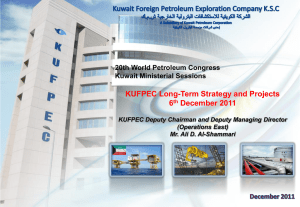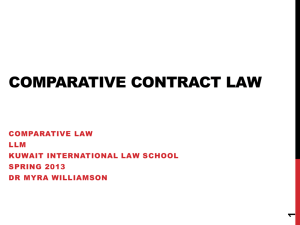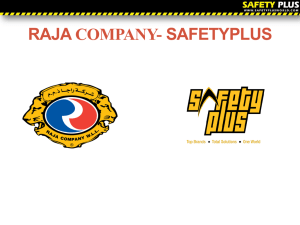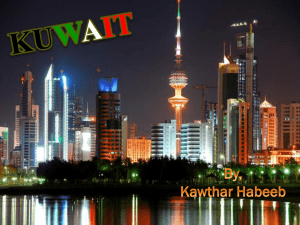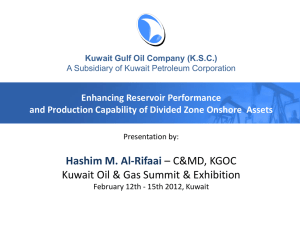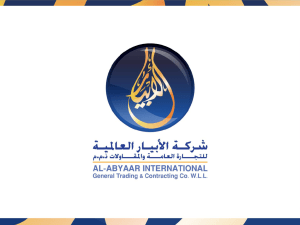Oil Gas and Petrochemicals
advertisement
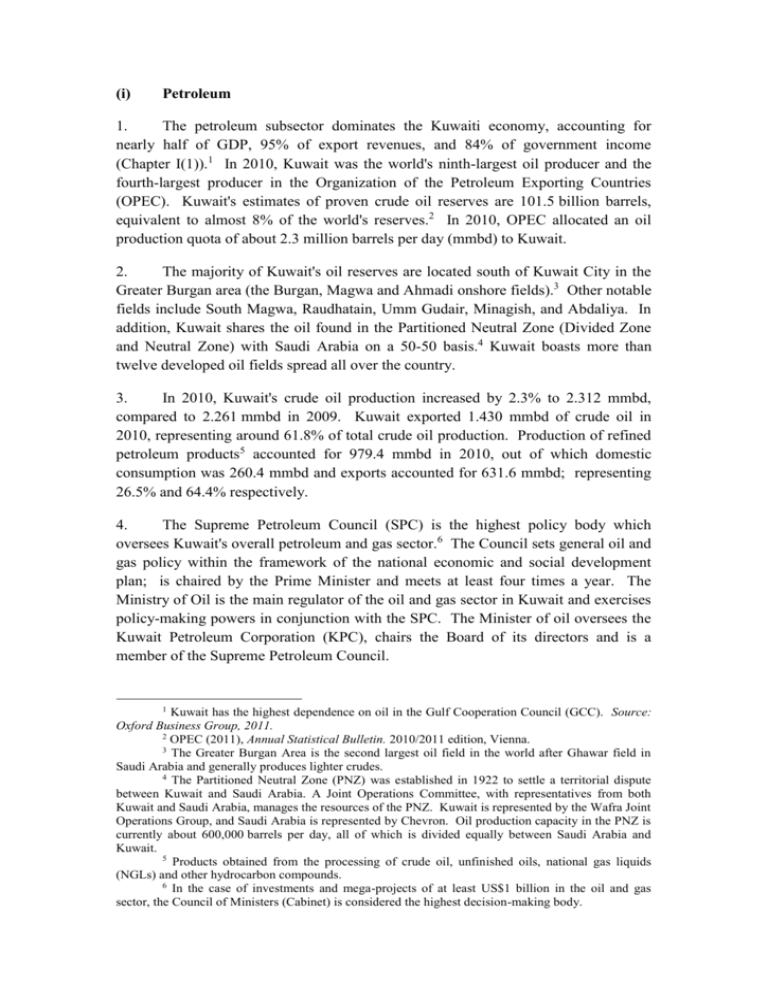
(i) Petroleum 1. The petroleum subsector dominates the Kuwaiti economy, accounting for nearly half of GDP, 95% of export revenues, and 84% of government income (Chapter I(1)).1 In 2010, Kuwait was the world's ninth-largest oil producer and the fourth-largest producer in the Organization of the Petroleum Exporting Countries (OPEC). Kuwait's estimates of proven crude oil reserves are 101.5 billion barrels, equivalent to almost 8% of the world's reserves.2 In 2010, OPEC allocated an oil production quota of about 2.3 million barrels per day (mmbd) to Kuwait. 2. The majority of Kuwait's oil reserves are located south of Kuwait City in the Greater Burgan area (the Burgan, Magwa and Ahmadi onshore fields).3 Other notable fields include South Magwa, Raudhatain, Umm Gudair, Minagish, and Abdaliya. In addition, Kuwait shares the oil found in the Partitioned Neutral Zone (Divided Zone and Neutral Zone) with Saudi Arabia on a 50-50 basis.4 Kuwait boasts more than twelve developed oil fields spread all over the country. 3. In 2010, Kuwait's crude oil production increased by 2.3% to 2.312 mmbd, compared to 2.261 mmbd in 2009. Kuwait exported 1.430 mmbd of crude oil in 2010, representing around 61.8% of total crude oil production. Production of refined petroleum products5 accounted for 979.4 mmbd in 2010, out of which domestic consumption was 260.4 mmbd and exports accounted for 631.6 mmbd; representing 26.5% and 64.4% respectively. 4. The Supreme Petroleum Council (SPC) is the highest policy body which oversees Kuwait's overall petroleum and gas sector.6 The Council sets general oil and gas policy within the framework of the national economic and social development plan; is chaired by the Prime Minister and meets at least four times a year. The Ministry of Oil is the main regulator of the oil and gas sector in Kuwait and exercises policy-making powers in conjunction with the SPC. The Minister of oil oversees the Kuwait Petroleum Corporation (KPC), chairs the Board of its directors and is a member of the Supreme Petroleum Council. 1 Kuwait has the highest dependence on oil in the Gulf Cooperation Council (GCC). Source: Oxford Business Group, 2011. 2 OPEC (2011), Annual Statistical Bulletin. 2010/2011 edition, Vienna. 3 The Greater Burgan Area is the second largest oil field in the world after Ghawar field in Saudi Arabia and generally produces lighter crudes. 4 The Partitioned Neutral Zone (PNZ) was established in 1922 to settle a territorial dispute between Kuwait and Saudi Arabia. A Joint Operations Committee, with representatives from both Kuwait and Saudi Arabia, manages the resources of the PNZ. Kuwait is represented by the Wafra Joint Operations Group, and Saudi Arabia is represented by Chevron. Oil production capacity in the PNZ is currently about 600,000 barrels per day, all of which is divided equally between Saudi Arabia and Kuwait. 5 Products obtained from the processing of crude oil, unfinished oils, national gas liquids (NGLs) and other hydrocarbon compounds. 6 In the case of investments and mega-projects of at least US$1 billion in the oil and gas sector, the Council of Ministers (Cabinet) is considered the highest decision-making body. 5. KPC, established in 1980, is the main operational entity responsible for Kuwait's hydrocarbon interests throughout the world. KPC is a state-owned holding corporation of ten specialized subsidiaries in Kuwait and worldwide, encompassing all aspects of the hydrocarbon industry (Table IV.1). Although state-owned, KPC is run by an independent management team and Board of Directors. 6. KPC and its subsidiary companies enjoy certain exclusive concessionary rights and privileges in the oil and gas subsector. For example, downstream petroleum activities (i.e. processing of crude oil to fuel) are fully controlled and owned by KNPC, while the exploration and production of natural gas are the sole responsibility of KOC. Table IV.1 Subsidiaries of the Kuwait Petroleum Corporation (KPC) Name Main activities Kuwait Oil Company (KOC) Upstream operations for oil exploration and extraction Kuwait National Petroleum Company (KNPC) Downstream operations of refining and distribution (local) Kuwait Foreign Petroleum Exploration Company (KUFPEC) Foreign upstream exploration and extraction operations Kuwait Petroleum International (KPI) Foreign downstream operations Petrochemical Industries Company (PIC) Petrochemical industry Kuwait Oil Tanker Company (KOTC) Marine transportation of hydrocarbons Kuwait Aviation Fuelling Company (KAFCO) Oil refuelling services Kuwait Gulf Oil Company (KGOC) Manages Kuwait's share of natural resources in the Partitioned Neutral Zone with Saudi Arabia Oil Development Company (ODC) In charge of "Kuwait Project" Oil Sector Services Company (OSSC) Shared services provider for oil sector Source: Kuwait Petroleum Corporation website: www.kpc.com.kw. 7. Under the Kuwaiti Constitution, all natural resources, including oil are owned by the State. The State alone has the right to exploit, utilize and safeguard those resources (Article 21). The right to concessions and/or monopolies for the exploitation of Kuwait's natural resources, including oil, may only be created by virtue of a law and for a limited time only (Article 152 and 153). According to Kuwait's Foreign Investment Law No. 8 of 2001, a foreign investor may carry out economic activities in industries other than oil and gas exploration and production (Chapter II(3)(i). 8. KPC has developed a long term strategy which aims to (i) increase Kuwait's crude oil production, mainly heavy oil from its current 2.3 mmbd to 4 mmbd by 20207; (ii) improve reservoir management practices; (iii) develop technically complex fields in a cost-effective manner; (iv) maximize the transfer of modern technology in oil extraction and (v) create job and training development opportunities for Kuwaitis. KPC plans to increase oil production by augmenting the potential of existing reservoirs and by adding the production of new discoveries. To finance KPC's plan, in February 2010, the Kuwaiti National Assembly approved a budget worth KD 35 billion until 2013/14, where the oil and gas sector's share represents around 84% of the budget. 9. Under KPC's umbrella, Kuwait Oil Company (KOC)'s responsibilities are the exploration, drilling, and production of oil and gas within Kuwait. KOC is also involved in the storage of crude oil and delivery to tankers for export. KOC is increasing its focus on developing the more challenging fields in North and West Kuwait in order to preserve the mature oil reserves in the Greater Burgan Area. 10. In partnership with international oil companies (IOCs), "Project Kuwait" was set up under the auspices of the Oil Development Company in the early nineties to help meet KPC's strategic objectives. This partnership between Kuwait and IOCs would be reflected in an Operating Service Agreement (OSA). Under the OSA and consistent with the Kuwaiti Constitution, Kuwait retains full ownership of petroleum production, reserves and revenue; and strategic management of the ventures. The OSA does not involve production sharing, concessions, or the "booking" of reserves by IOCs. The IOC, however, maintains control over the operational management; acts as a contractor or service provider and employs a set quota of 30% of Kuwaiti labour. In addition, the IOC incurs 100% of the capital and operating costs and is paid in return a per-barrel fee, along with allowances for capital recovery and incentive fees for increasing reserves. 11. So far and in the oil upstream subsector, KOC has only managed in 2007 to sign a memorandum of understanding with Exxon-Mobil to produce heavy crude oil. An OSA has however been recently signed with Royal Dutch Shell to develop natural gas. 12. The majority of Kuwaiti crude oil exports, around 83.3% were exported to Asia in 2010, followed by North America (8.9%) and Europe (4.3%) (Table IV.2). Most of the crude oil is sold on term contracts, with the price linked to the respective market benchmark crude in each of the Asian, European and the U.S. markets. 7 Oil production levels are expected to grow rapidly over the next five years (2010-2015), according to Kuwaiti investment firm Global Investment House. Table IV.2 Kuwait's exports of crude oil, and refined productsa (by region), 2009-10 (Million barrels) 2009 Exports to Africa Refine d Produc ts % share in 2010 Crude oil Refined Product s Crude oil Refined Products 40 - 42 - 2.90 - 1,162 620 1,199 582 83.80 92.0 Europe 51 52 62 49 4.30 7.75 The Middle East - - - - - - North America 95 1 127 1 8.90 0.16 Latin America - - - - - - 1,348 673.5 1,430 632 100 100 Asia and Pacific Total a Crude oil 2010 Including liquefied petroleum and natural gas. Source: OPEC Statistical Bulletin (2009, 2010/2011). 13. Kuwait's main port for crude oil exports is Mina al-Ahmadi. Operational oil export terminals are Mina Abdullah, Shuaiba and Mina Al Zour. A new terminal is planned on Bubiyan Island to handle increased crude oil production, generated by the Northern fields. 14. In addition to local oil production, Kuwait is also engaged in crude oil and natural gas exploration, development and production in 15 countries in Africa, the Middle East and Asia, through the Foreign Petroleum Exploration Company (KUFPEC). A subsidiary of KPC, KUFPEC is an international oil company, which participates in joint ventures with companies in oil and gas exploration and production both as an operator and partner around the world. In 2009, KUFPEC's total operating revenue amounted to US$820.9 million, of which oil and condensate represented 47.7% of total revenues, while gas accounted for 52.3%. Total investments amounted to US$760 million in 2010. According to the authorities, KUFPEC aims to produce around 100 thousand barrels per day (oil equivalent) of crude oil by 2015. 15. Procurement by oil companies is generally excluded from the Public Tenders Law and the regulatory controls of the Central Tenders Committee (CTC). However, when there are purchases of either a minimum value of KD 5 million and/or a variation by more than 10% of the contract value, in the case of three oil companies – KOC, KNPC, KOTC- and the Petrochemical Industries Company (PIC), these procurements must be managed by the CTC under the Public Tenders Law. (a) Downstream petroleum activities 16. Downstream petroleum activities (i.e. the processing of crude oil to fuel) are fully controlled and owned by the Kuwait National Petroleum Company (KNPC), a subsidiary of KPC. KNPC is in charge of refining operations and aims to be the best refiner in the Gulf region. Kuwait's refining capacity stands at around 936,000 barrels per day (b/d). There are three refineries in Kuwait: Mina al-Ahmadi is the country's largest refinery with a capacity of 466,000 b/d, followed by Mina Abdullah (270,000 b/d) and Shuaiba (200,000 b/d). A fourth new refinery is estimated to cost around US$15 billion and once operational, it would be able to process ultra-heavy oil, at a refining capacity of 600,000 b/d. 17. Kuwait's production of refined products increased to 979,000 b/d in 2010 from 892,700 b/d in 2009. The majority of Kuwait's refined petroleum exports; around 92% was exported to Asia in 2010, followed by Europe (7.75%) and North America (0.16%) (Table IV.2). 18. Following the refining process, petroleum products are deposited in large storage depots at the refineries and then shipped through seven pipelines to two main storage depots (Sabhan and Al-Ahmadi). Petroleum products are supplied to domestic consumers through 99 filling gas stations across the country. The distribution and the storage facilities are fully controlled and owned by KNPC. Some gas stations have been privatized. 19. Since 1999, Kuwait's domestic fuel supply has been unleaded gasoline. Table IV.3 shows regulated prices of refined petroleum and gas products. Table IV.3 Regulated prices of refined petroleum and gas products No. Item Current regulated price HS classification 1. Gasoline 114 fils/Litre 27101121 2. Diesel 87.5 fils/Litre 27101130-3 3. Kerosene 87.5 fils/Litre 27101129 4. Fuel Oil .. 27101140 .. Not available. Exchange rate: 1 USD= 0.275 Kuwaiti Dinars (KWD); 1 KWD= 1000 fils. Source: OPEC (2010/2011), Annual Statistical Bulletin. 20. Kuwait Petroleum International (KPI), known as Q8, manages KPC's refining and marketing operations internationally, with approximately 4,000 retail stations across six European countries.8 A top ten energy conglomerate, KPI owns an 80,000 b/d refinery in the Netherlands and has a 50-50 joint venture with AGIP in the 240,000 b/d refinery in Italy. According to the authorities, in March 2011, a new 5050 joint-venture between KPI and China Petroleum and Chemical Corporation (Sinopec) was approved to build a refinery and petrochemical complex in south China. Expected to be operational in 2014/15, the plant will process 100% Kuwaiti crude oil, with a refining capacity of 300,000 b/d. Another refinery has been commissioned by KPI to operate in Vietnam by 2014/15, with a refining capacity of 200,000 b/d. 21. Kuwait has not bound any of its crude oil and petroleum related products in its Uruguay Round Schedule of Concessions. The MFN GCC applied tariffs on petroleum products, such as crude oil, refined petroleum oils; petroleum coke and petroleum jelly are 5%. (ii) Natural gas 22. Kuwait ranks 18th in global natural gas reserves. In January 2010, Kuwait's estimated natural gas reserves stood at nearly 1,784 billion cubic metres, about 1% of the world's total. Kuwait produces mainly dry natural gas, approximately 11.9 billion cubic metres in 2010. According to OPEC, the volume of the gas which is flared is only about 1.8% of the total produced (Table IV.4). Table IV.4 Gas production and utilization, 2005-10 (Million cubic metres) 2005 2006 2007 2008 2009 2010 Gross production 13,300 13,670 13,310 13,870 11,689 11,950 Marketed production 12,300 12,410 12,060 12,700 11,489 11,733 Flared 1 260 250 200 200 217 Re-injection - - - - - - 8 Italy, Denmark, Belgium, the Netherlands, Luxembourg and Sweden. Shrinkage 1,000 1,000 1,000 970 - - Note: Marketed production corresponds to gross production, minus the volumes of gas flared or re-injected into the fields, minus the shrinkage. Source: OPEC (2010/2011), Annual Statistical Bulletin. 23. The majority of natural gas in Kuwait is associated gas (i.e. gas found and produced in conjunction with crude oil). In 2006, non-associated gas was first discovered in the deep Jurassic reservoirs in the northern fields of Sabriya, Rahiya, Mutriba and Um Niga. 24. Natural gas in Kuwait is a multipurpose resource. While it is mainly used for domestic electricity generation, it is also used for water desalination, as a feedstock for the petrochemical industry and to free up additional crude oil for export. Since current levels of natural gas production do not meet national consumption levels, especially with the increasing power shortages during the summer months, the authorities fill in the current gap by imports. 25. Since 2009, Kuwait has taken the initiative among the GCC countries in importing liquefied natural gas (LNG). In 2009, Kuwait imported around 25 trillion BTU (i.e. 70 million cubic meters). Kuwait has recognized the importance of LNG to cover the shortage in gas in Kuwait especially during summer season from economic and environment point of views. Therefore, Kuwait has succeeded in procuring a long term contract for LNG imports until 2013. 26. The exploration and production of natural gas in Kuwait are under the responsibility of KOC and policy related matters fall under KPC's ambit. KGOC is in charge of the exploration and production of natural gas in the partitioned Neutral Zone and offshore operations. In order to reduce Kuwait's dependence on gas imports and become self-sufficient, the authorities aim to increase production to an estimated 19.3 billion cubic meters by 2014 by maximizing the exploration, development and production of non-associated gas and by adopting a zero flaring policy for both onshore and offshore operations, targeting 1% gas flaring.9 27. In February 2010, a five-year Enhanced Technical Services Agreement (ETSA) has been signed between KOC and Shell Kuwait Exploration and Development B.V., a subsidiary of Royal Dutch Shell.10 Shell aims to play a technical and advisory role in the development of non-associated gas in the complex northern fields of Marrat and Najma Sargelu Reservoirs. 9 KPC has developed environment-friendly policies such as a greenhouse gas (GHG) management strategy and the potential to use international carbon financing mechanisms like Clean Development Mechanism (CDM). 10 Shell is a partner with government-owned Qatar Petroleum in the Qatargas LNG project. 28. Mina al-Ahmadi GasPort is the main port for regasification and is the Persian Gulf's first regasification terminal. Mina al-Ahmadi's capacity is around 10,300 tonnes of LNG per day. (iii) Petrochemicals 29. Kuwait is an active player in the petrochemical industry. The first chemical fertilizer complex both in Kuwait and the region, comprising ammonia, urea, ammonium sulphate, and sulphuric acid production was completed in 1966 in the industrial area of Shuaiba. 30. The main petrochemical products include fertilisers, olefins and aromatics. In 2010, Kuwait's total production capacity was 7,090 million tons (Table IV.5). In 2010, Kuwait's total sales of fertilizers reached an amount of US$347 million, a 65% increase from 2009. Kuwait exports its petrochemical products globally. Table IV.5 Kuwait's production capacity of petrochemical products (2010) (Million tons) Product Fertilizers 2010 Urea Ammonia Olefins Ethylene Polyethylene Ethylene glycol Aromatics 660 1,650 900 1,000 Polypropylene 150 Paraxylene 830 Benzene 400 Styrene monomer 450 Total Source: 1,050 7,090 Kuwaiti authorities. 31. According to the authorities, producers of fertilizers may benefit from a regulated price of natural gas, which is available to all users in Kuwait. The feedstock of other petrochemical industries is linked to international crude oil prices. 32. The Petrochemical Industries Company (PIC), a subsidiary of KPC and petrochemical conglomerate, is in charge of the petrochemical industry in Kuwait. PIC has partnered with several national and foreign companies in the form of jointventures to produce diverse petrochemical products (Table IV.6). In addition, PIC owns two fertilizer plants for the production of ammonia and urea and one polypropylene plant. Table IV.6 Kuwait's petrochemical companies Petrochemical Joint Venture Companies Ownership structure Activities/responsibilities Equate Petrochemical PIC (42.5%); DOW Company Chemical Company (42.5%) [U.S. Company]; Boubyan Petrochemical Company (9%); AlQurain Petrochemical Industries Company (6%) - produces Polyethylene and Ethylene Glycol - operates PIC's Polypropylene plant - operates TKOC's two plants for the manufacturing of Ethylene and Ethylene Glycol - operates TKSC's Styrene plant - operates TKAC's Paraxylene and Benzene plants and Sea Cooling Towers The Kuwait Olefins Company (TKOC) PIC (42.5%); DOW Chemical Company (42.5%); Boubyan Petrochemical Company (9%); AlQurain Petrochemical Industries Company (6%) - owns the Olefins –II Complex - produces Ethylene Glycol The Kuwait Aromatics Company (TKAC) PIC (40%); KNPC (40%); Al-Qurain Petrochemical Industries Company (20%) - owns the Kuwait Paraxylene Production Company (KPPC) - produces Paraxylene and Benzene The Kuwait Styrene Company (TKSC) TKAC (57.5%) and DOW Chemical Company (42.5%) - produces Styrene monomer - obtains Benzene feedstock from TKAC and Ethlyne from TKOC Al-Qurain Petrochemical Industries Company (QPIC) PIC (10%) Gulf Petrochemical Industries Company (GPIC) PIC (33%); Government of Bahrain (33%); Saudi Arabia's SABIC (33%) - produces Ammonia, Urea, and Methanol MEGlobal PIC (50%); DOW Chemical Company (50%) - owns plants in Canada that produce Mono -Ethylene Glycole and DiEhtylene Glycol - based in Canada MEGlobal BV PIC (50%); DOW Chemical Company (50%) - markets Ethylene Glycol produced by the partners and production by MEGlobal BV. - based in Dubai PIC-Canada Company PIC (100%) - manages PIC's investments in MEGlobal - based in Canada Equipolymers Company PIC (50%); DOW Chemical Company (50%) - manufactures PTAa/PET and markets PET - with two PET plants in Germany a PTA is a feedstock used in the production of PET, which is used in making bottles and containers for soft drinks, food and other liquids Source: WTO Secretariat Compilation. 33. Kuwait aims to be a global petrochemical player and attract investment opportunities especially in Asia. In March 2011, a new 50-50 joint venture between KPI and China Petroleum and Chemical Corporation (Sinopec) was approved to build a refinery and petrochemical complex in south China at a cost of around US$8.7 billion. Expected to be operational in 2014/15, an ethylene plant will have an annual production capacity of one million tons. Moreover, a new olefins project, Olefins III Project is underway. Olefins-III project will comprise a world-scale Cracker Plant of Ethylene capacity 1.4 million tons per annum and derivative units to produce Polyethylene, Ethylene, Glycol, Polypropylene and other specialty products. The Project Feasibility Study is under development to decide the feedstock mix, complex configuration, derivative slate, financing options and implementation strategy. The Project is planned to be operational in year 2017. 34. PIC is jointly considering ways of integrating the refinery and petrochemical operations with Kuwait National Petroleum Company (KNPC), in order to improve the use of hydrocarbons resources in Kuwait.

